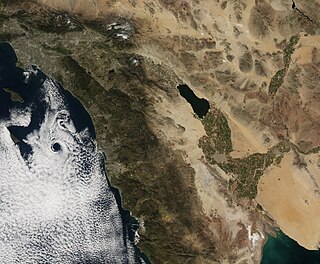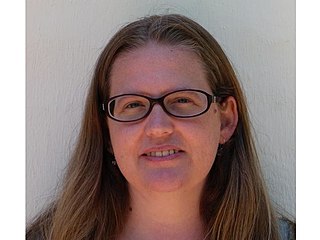
Seismology is the scientific study of earthquakes and the propagation of elastic waves through the Earth or through other planet-like bodies. The field also includes studies of earthquake environmental effects such as tsunamis as well as diverse seismic sources such as volcanic, tectonic, glacial, fluvial, oceanic, atmospheric, and artificial processes such as explosions. A related field that uses geology to infer information regarding past earthquakes is paleoseismology. A recording of Earth motion as a function of time is called a seismogram. A seismologist is a scientist who does research in seismology.
Hiroo Kanamori is a Japanese seismologist who has made fundamental contributions to understanding the physics of earthquakes and the tectonic processes that cause them.

The New Madrid Seismic Zone, sometimes called the New Madrid Fault Line, is a major seismic zone and a prolific source of intraplate earthquakes in the Southern and Midwestern United States, stretching to the southwest from New Madrid, Missouri.

The 1987 Whittier Narrows earthquake occurred in the southern San Gabriel Valley and surrounding communities of southern California, United States, at on October 1. The moderate 5.9 magnitude blind thrust earthquake was centered several miles north of Whittier in the town of Rosemead, had a relatively shallow depth, and was felt throughout southern California and southern Nevada. Many homes and businesses were affected, along with roadway disruptions, mainly in Los Angeles and Orange counties. Damage estimates ranged from $213–358 million, with 200 injuries, three directly-related deaths, and five additional fatalities that were associated with the event.

The 2006 Greece earthquake – also known as the Kythira earthquake – occurred on January 8 at 13:34:53 local time and was felt throughout the entire eastern Mediterranean basin. The earthquake an magnitude 6.7 and a maximum Mercalli intensity of VII. Its epicentre was located just off the island of Kythira about 200 kilometres (120 mi) south of Athens.
Kate Hutton, nicknamed the Earthquake Lady, Dr. Kate, or Earthquake Kate, was a staff seismologist at the California Institute of Technology in Pasadena, California, where she monitored Southern California's earthquake activity for 37 years.
Seismic magnitude scales are used to describe the overall strength or "size" of an earthquake. These are distinguished from seismic intensity scales that categorize the intensity or severity of ground shaking (quaking) caused by an earthquake at a given location. Magnitudes are usually determined from measurements of an earthquake's seismic waves as recorded on a seismogram. Magnitude scales vary on what aspect of the seismic waves are measured and how they are measured. Different magnitude scales are necessary because of differences in earthquakes, the information available, and the purposes for which the magnitudes are used.

Lucile M. Jones is a seismologist and public voice for earthquake science and earthquake safety in California. One of the foremost and trusted public authorities on earthquakes, Jones is viewed by many in Southern California as the "seismologist-next-door," who is frequently called up on to provide information on recent earthquakes.

The International Seismological Centre (ISC) is a non-governmental, nonprofit organisation charged with the final collection, definitive analysis and publication of global seismicity. The ISC was formed in 1964 as an international organisation independent of national governments that would carry on the work of the International Seismological Summary in collecting and analyzing seismic data from around the world, and particularly to handle increased flow of data from the World-Wide Standard Seismograph Network (WWSSN), also established that year. The ISC considers its prime task to be the collection and re-analysis of all available earthquake seismic date in order to produce definitive data on earthquakes. The ISC's catalog is considered "the most complete and authoritative final depositary of global earthquake parameter data."

The 2008 Illinois earthquake was one of the largest earthquakes ever recorded in the Midwest state of Illinois. This moderate strike-slip shock measured 5.2 on the moment magnitude scale and had a maximum Mercalli intensity of VII. It occurred at on April 18 near West Salem and Mount Carmel, Illinois, within the Wabash Valley Seismic Zone. Earthquakes in this part of the country are often felt at great distances.
George W. Housner was a professor of earthquake engineering at the California Institute of Technology and National Medal of Science laureate.

The Brawley Seismic Zone (BSZ), also known as the Brawley fault zone, is a predominantly extensional tectonic zone that connects the southern terminus of the San Andreas Fault with the Imperial Fault in Southern California. The BSZ is named for the nearby town of Brawley in Imperial County, California, and the seismicity there is characterized by earthquake swarms.
An ocean-bottom seismometer (OBS) is a seismometer that is designed to record the earth motion under oceans and lakes from man-made sources and natural sources.

Weston Observatory is a geophysical research laboratory of the Department of Earth and Environmental Sciences at Boston College. The Observatory is located in the town of Weston, Massachusetts, about 13 miles (21 km) west of downtown Boston.
Harry Oscar Wood was an American seismologist who made several significant contributions in the field of seismology in the early twentieth-century. Following the 1906 earthquake in San Francisco, California, Wood expanded his background of geology and mineralogy and his career took a change of direction into the field of seismology. In the 1920s he co-developed the torsion seismometer, a device tuned to detect short-period seismic waves that are associated with local earthquakes. In 1931 Wood, along with another seismologist, redeveloped and updated the Mercalli intensity scale, a seismic intensity scale that is still in use as a primary means of rating an earthquake's effects.
The Advanced National Seismic System (ANSS) is a collaboration of the U.S. Geological Survey (USGS) and regional, state, and academic partners that collects and analyzes data on significant earthquakes to provide near real-time information to emergency responders and officials, the news media, and the public. Such information is used to anticipate the likely severity and extent of damage, and to guide decisions on the responses needed.

Jeanne L. Hardebeck is an expert in earthquakes and seismology. She has a Ph.D. in Geophysics and has worked as a Research Geophysicist for the United States Geological Survey (USGS) since 2004. Throughout her career, Hardebeck has dedicated herself to her work and has provided critical contributions to her field including the development of new research methods to better understand issues such as the state of stress and the strength of faults.
Joan S. Gomberg is a research geophysicist at the United States Geological Survey. She serves as an adjunct professor at the University of Washington. She is interested in subduction zone science, and studies how earthquakes trigger each other and how faults can slip. Gomberg is a Fellow of the American Geophysical Union. She was the first person to demonstrate how dynamic stress associated with seismic waves can trigger other earthquakes.









